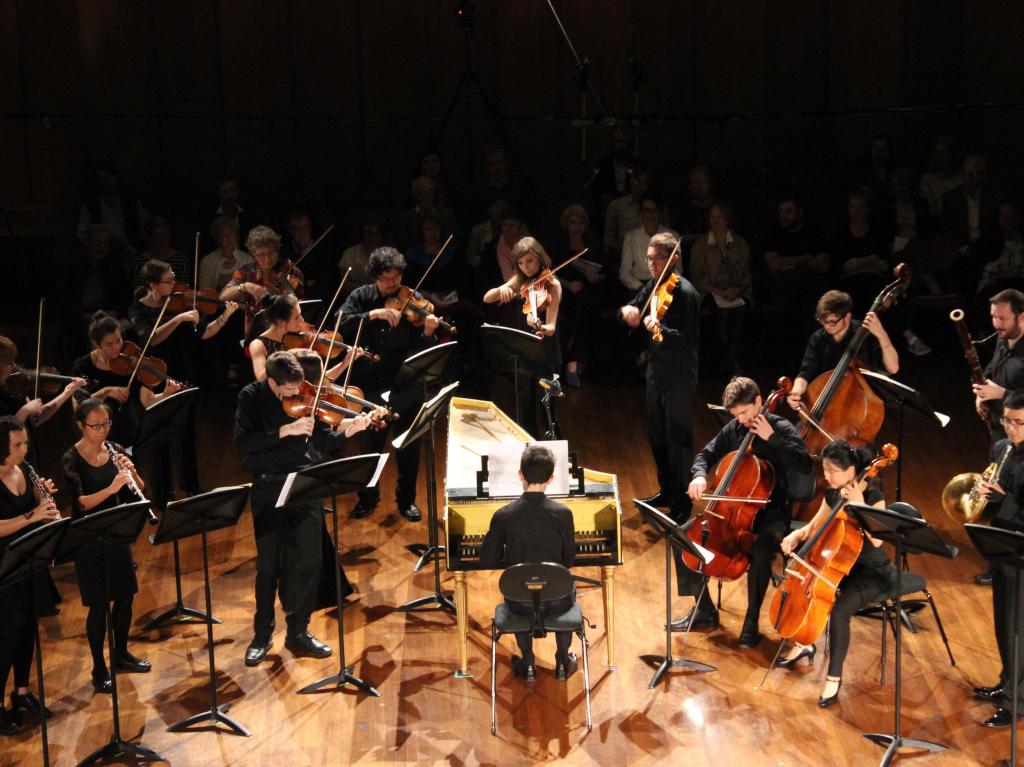The Brandenburg orchestra. Image supplied by ANAM.
As Artistic Director of the Australian National Academy of Music, Paul Dean does not shy away from challenging the talented young musicians in his care with performance opportunities that stretch their technical resources as well as their musical horizons.
Drawing a connection between essential features of the music of Bach and Hindemith, Dean finds validity in the contention that Hindemith’s Kammermusik series for solo and small ensembles are the Brandenburg concerti of the twentieth century. These works can also be seen as an antidote to the relatively restricted number of items from the Romantic repertoire that pervades mainstream concerts with such monotonous regularity.
For the second in this series of concerts juxtaposing Bach’s Brandenburg concertos with Hindemith’s Kammermusik, Paul Dean collaborated with renowned Baroque violin specialist, Elizabeth Wallfisch. Bach’s Brandenburg Concerto No. 1 is particularly demanding and tricky to coordinate, especially without a conductor. Although an essential part of their training is to learn how to lead and read each other, some ragged ensemble work was apparent at times. With little solos springing up all over the place it was a big ask. Nevertheless, as the featured element of a concerto that may have originated as an introductory sinfonia to a ‘Hunting’ cantata, the horns made a valiant attempt to convey the lusty rustic feel of the piece while the Adagio elicited some lovely oboe playing full of pathos and nicely interwoven with a delicate solo violin.
Bach’s Concerto No. 2 appeared to present fewer difficulties regarding coordination and provided an uplifting conclusion to the evening. As with all the items on the program, a particular instrument was featured; in this instance it was Rainer Saville who impressed with the virtuoso trumpet part, producing a clear, polished sound with clean articulation.
The two Bach concerti were separated by Hindemith’s Kammermusik Nos. 3 and 4, an interval and assorted rearrangements of the furniture. In an attempt to keep the last to a minimum, the hall was set up so that the Bach pieces were performed at one end and the Hindemith at the other, with the audience surrounding the players. A further aim was to provide a different concert experience for both players and audience. Doubtless some members of the audience were better placed than others to obtain a balanced version of the music, but everybody would have been bowled over by the virtuosity on display in the Hindemith pieces.
With Paul Dean conducting, both the Cello Concerto and the Violin Concerto were polished and coherent. This is music that is dear to him and it showed. The time and effort that has been invested in preparing these complex works has resulted in a rewarding journey of discovery and delight for all concerned. It is music that deserves much greater exposure. Certainly some of it is ‘difficult’ and requires repeated listening to appreciate it fully, but much of it is accessible and instantly gratifying. The deeply expressive lyricism of the slow ‘Night Piece’ movement of Kammermusik No. 3, where the sole violin is heard against the lower strings, was a strikingly beautiful feature of the concert.
As well as splendid playing from the ensemble as a whole, the alumni soloists, Robert Manley (cello) and Emily Sheppard (violin) were extraordinary. That over-worked adjective ‘amazing’ could not have been more appropriate when applied to these two gifted string players and I heard it coming from many members of the audience after the concert. The reception that greeted Emily Sheppard at the end of her fiendishly difficult and wonderfully accomplished performance was tremendous. You could not have found a more enthusiastic response at a football match than the one coming from ANAM colleagues listening in the balcony. Their appreciation of the achievements of their fellow musicians was a tribute to the supportive spirit that is an essential ingredient of ANAM.
While the bulk of ANAM musicians were thrilling audiences in their home venue, one of their many stars, Anne-Marie Johnson, was busy winning the 2014 Dorcas McClean Travelling Scholarship for Violinists with Elgar’s Violin Concerto at the University of Melbourne. ANAM audiences have already been enchanted by her sensitive interpretation of Vaughan-Williams’ The Lark Ascending as part of the concert that launched ANAM’s 2014 season; now they will be able to hear her play with the Melbourne Symphony Orchestra in a gala concert conducted by Benjamin Northey. This new addition to the $40,000 bursary is further recognition of the importance of nurturing talented young musicians – a function that ANAM performs so well.
Rating: 4 out of 5 stars
Brandenburg & Kammermusik
Conductor: Paul Dean
ANAM musicians
Australian National Academy of Music, South Melbourne Town Hall
www.anam.com.au
17 April





